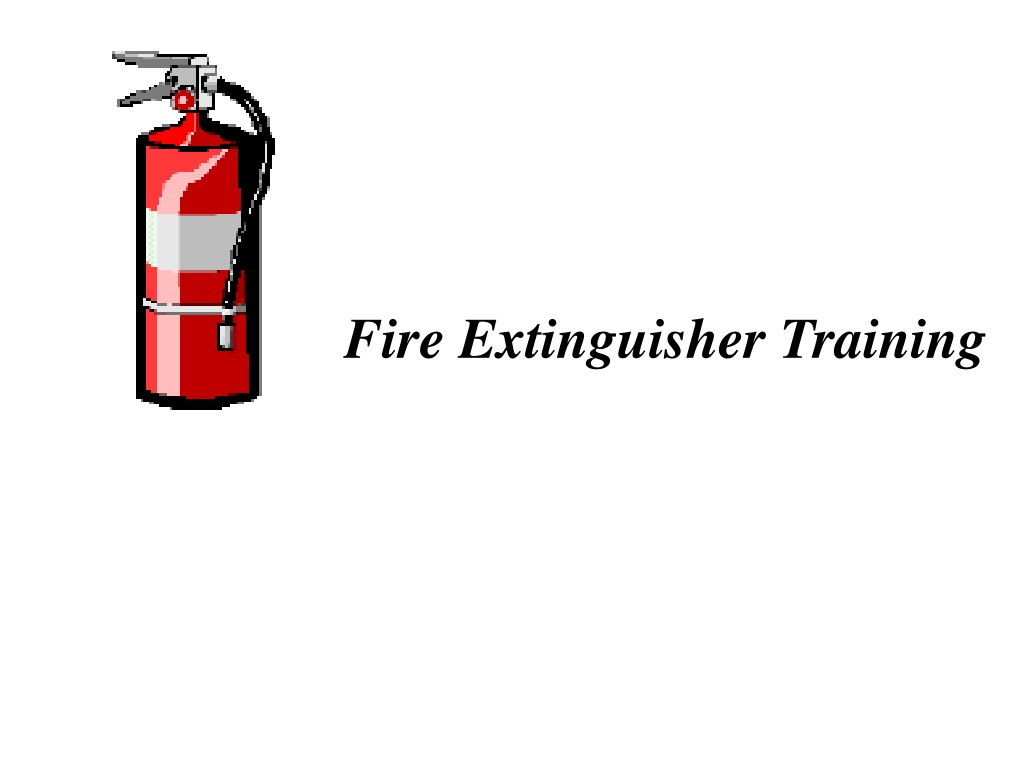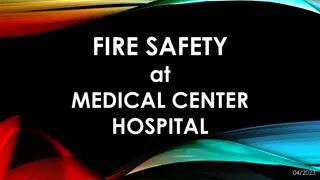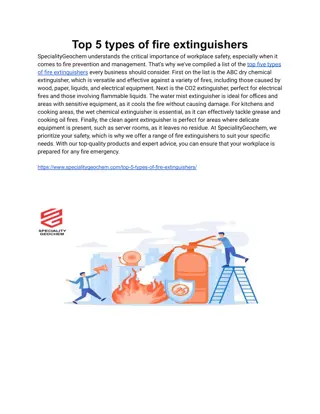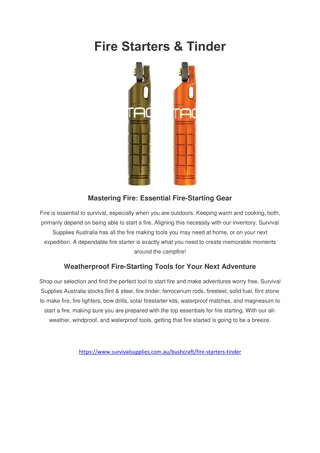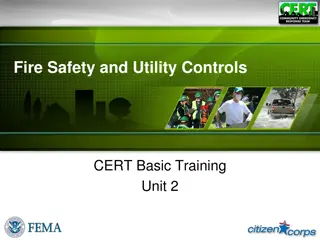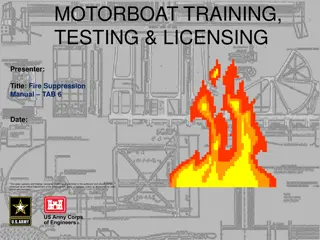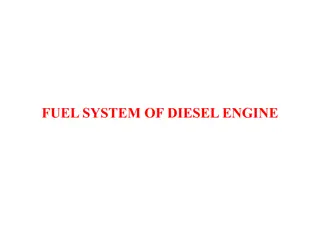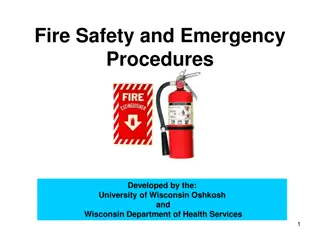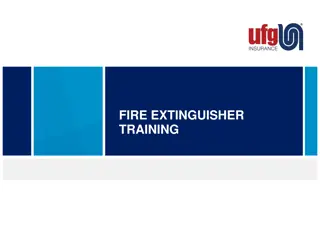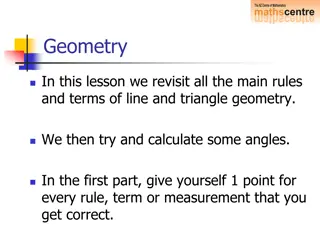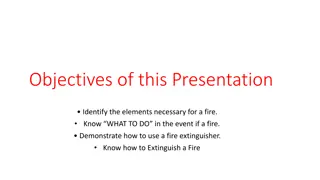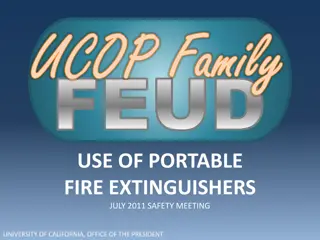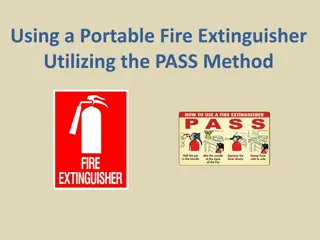All About Fire Extinguishers: Anatomy, Triangle, Fuel Classifications & Types
Discover essential information on fire extinguishers, including their anatomy, the concept of the fire triangle, fuel classifications, and different types of fire extinguishers. Learn about the components of a fire extinguisher, the importance of understanding fuel classifications, and which type of extinguisher to use for different classes of fires.
Download Presentation

Please find below an Image/Link to download the presentation.
The content on the website is provided AS IS for your information and personal use only. It may not be sold, licensed, or shared on other websites without obtaining consent from the author. Download presentation by click this link. If you encounter any issues during the download, it is possible that the publisher has removed the file from their server.
E N D
Presentation Transcript
Fire Extinguisher Anatomy PRESSURE GAUGE (not found on CO2 extinguishers) DISCHARGE LEVER CARRYING HANDLE DISCHARGE LOCKING PIN AND SEAL DISCHARGE HOSE DATA PLATE BODY DISCHARGE NOZZLE DISCHARGE ORIFICE
Fire Emergency Response Rescue Alarm Contain Extinguish ASK WHAT DO I DO IF I SEE A FIRE?
The Fire Triangle Fire Safety, at its most basic, is based upon the principle of keeping fuel sources and ignition sources separate.
The Fire Triangle Three things must be present at the same time to produce fire: 1. Enough OXYGEN to sustain combustion 2. Enough HEAT to reach ignition temperature 3. Some FUEL or combustible material Together, they produce the CHEMICAL REACTION that is fire Take away any of these things and the fire will be extinguished
Fuel Classifications Fires are classified according to the type of fuel that is burning. If you use the wrong type of fire extinguisher on the wrong class of fire, you might make matters worse. Its very important to understand the four different fire (fuel) classifications
Fuel Classifications Class A: Wood, paper, cloth, trash, plastics solids that are not metals. Class B: Flammable liquids gasoline, oil, grease, acetone. Includes flammable gases. Class C: Electrical energized electrical equipment. As long as it s plugged in. Class magnesium. Requires special extinguishing agents. D: Metals potassium, sodium, aluminum,
Fuel Classifications Most fire extinguishers will have a pictograph label telling you which types of fire the extinguisher is designed to fight. For example, a simple water extinguisher might have a label like this which means it should only be used on Class A fires.
Types of Fire Extinguishers Different types of fire extinguishers are designed to fight different classes of fire. The 3 most common types of fire extinguishers are: 1. Water (APW) 2. Carbon Dioxide (CO2) 3. Dry Chemical (ABC, BC, DC)
Types of Fire Extinguishers 1. Water (APW) Fire Extinguishers Large silver fire extinguishers that stand about 2 feet tall and weigh about 25 pounds when full. APW stands for Air-Pressurized Water. Filled with ordinary tap water and pressurized air, they are essentially large squirt guns.
Types of Fire Extinguishers 1. Water (APW) Fire Extinguishers APWs extinguish fire by taking away the heat element of the Fire Triangle.
Types of Fire Extinguishers 1. Water (APW) Fire Extinguishers APWs are designed for Class A fires only: Wood, paper, cloth. Using water on a flammable liquid fire could cause the fire to spread. Using water on an electrical fire increases the risk of electrocution. If you have no choice but to use an APW on an electrical fire, make sure the electrical equipment is un-plugged or de-energized.
Types of Fire Extinguishers 1. Water (APW) Fire Extinguishers APWs will be found in older buildings, particularly in public hallways. They will also be found in computer laboratories. It is important to remember, however, that computer equipment must be disconnected from its electrical source before using a water extinguisher on it.
Types of Fire Extinguishers 2. Carbon Dioxide Fire Extinguishers The pressure in a CO2 extinguisher is so great, bits of dry ice may shoot out of the horn! CO2 cylinders are red. They range in size from 5 lbs to 100 lbs or larger. On larger sizes, the horn will be at the end of a long, flexible hose.
Types of Fire Extinguishers 2. Carbon Dioxide Fire Extinguishers CO2s are designed for Class B and C (Flammable Liquids and Electrical Sources) fires only! CO2s will frequently be found in laboratories, mechanical rooms, kitchens, and flammable liquid storage areas. In accordance with NFPA regulations (and manufacturers recommendations), all CO2 extinguishers must undergo hydrostatic testing and recharge every 5 years.
Types of Fire Extinguishers 2. Carbon Dioxide Fire Extinguishers Carbon dioxide is a non- flammable gas that takes away the oxygen element of the fire triangle. Without there is no fire. oxygen, CO2 is very cold as it comes out of the extinguisher, so it cools the fuel as well.
Types of Fire Extinguishers 2. Carbon Dioxide Fire Extinguishers A CO2 may be ineffective in extinguishing a Class A fire because it may not be able to displace enough oxygen to successfully put the fire out. Class A materials may also smolder and re-ignite.
Types of Fire Extinguishers 3. Dry Chemical (ABC) Fire Extinguishers Dry chemical extinguishers put out fire by coating the fuel with a thin layer of dust. This separates the fuel from the oxygen in the air. The powder also works to interrupt the chemical reaction of fire.These extinguishers are very effective at putting out fire.
Types of Fire Extinguishers 3. Dry Chemical (ABC) Fire Extinguishers ABC extinguishers are red. On campus, they range in size from 5 to 20 lbs. ABC fire extinguishers are filled with a fine, yellow powder. The greatest portion of this powder is composed of monoammonium phosphate. The extinguishers are pressurized with nitrogen.
Types of Fire Extinguishers 3. Dry Chemical (ABC) Fire Extinguishers Dry chemical extinguishers come in a variety of types You may see them labeled: DC (for DryChemical ) ABC (can be used on Class A, B, or C fires) BC (designed for use on Class B and C fires)
Types of Fire Extinguishers 3. Dry Chemical (ABC) Fire Extinguishers It is extremely important to identify which types of dry chemical extinguishers are located in your area! An ABC extinguisher will have a label like this, indicating it may be used on Class A, B and C fires. You don t want to mistakenly use a BC extinguisher on a ClassAfire thinking that it was an ABC extinguisher.
Types of Fire Extinguishers 3. Dry Chemical (ABC) Fire Extinguishers Dry chemical extinguishers with powder designed for Class B and C fires ( BC extinguishers) may be located in places such as commercial kitchens and areas with flammable liquids. You will typically find ABCs in public hallways of new buildings, in laboratories, break rooms, offices, chemical storage areas, mechanical rooms, vehicles, etc.
How to Use a Fire Extinguisher It s easy to remember how to use a fire extinguisher if you remember the Acronym P A S S
Fighting the Fire Pull the pin P Aim low at the base of flames A Squeeze the handle S Sweep side to side S IF YOU DECIDE TO FIGHT FIRE, USE P.A.S.S. ACRONYM TO REMEMBER HOW TO OPERATE THE EXTINGUISHER PROPERLY.
How to Use a Fire Extinguisher Pull the pin This will allow you to discharge the extinguisher
How to Use a Fire Extinguisher Aim at the base of the fire Hit the fuel. If you aim at the flames... the extinguishing agent will fly right through and do no good.
How to Use a Fire Extinguisher Squeeze the top handle This depresses a button that releases the pressurized extinguishing agent.
How to Use a Fire Extinguisher Sweep from side to side .. until the fire is completely out. Start using the extinguisher from a safe distance away, then slowly move forward. Once the fire is out, keep an eye on the area in case it re-ignites.
Rules for Fighting Fires Fires can be very dangerous and you should always be certain that you will not endanger yourself or others when attempting to put out a fire. For this reason, when a fire is discovered 1. Assist any person in immediate danger to safety, if it can be accomplished without risk to yourself. Call 911 or activate the building fire alarm. The fire alarm will notify the fire department and other building occupants and shut off the air handling system to prevent the spread of smoke. 2. If the fire is small (and Only after having done these 2 things), you may attempt to use an extinguisher to put it out. However . . . .
Rules for Fighting Fires . . . before deciding to fight the fire, keep these things in mind: 1. Know what is burning. If you don t know what s burning, you won t know what kind of extinguisher to use. 2. Even if you have an ABC fire extinguisher, there may be something in the fire that is going to explode or produce toxic fumes. Chances are you will know what s burning, or at least have a pretty good idea, but if you don t, let the fire department handle it.
Rules for Fighting Fires . . . before deciding to fight the fire, keep these things in mind: 3. Is the fire spreading rapidly beyond the point where it started? The time to use an extinguisher is at the beginning stages of the fire. 4. If the fire is already spreading quickly, it is best to simply pull the fire alarm and evacuate the building. As you evacuate a building, close doors and windows behind you as you leave. This will help to slow the spread of smoke and fire.
Rules for Fighting Fires Do not fight the fire if: You don t have adequate or appropriate equipment. If you don t have the correct type or large enough extinguisher, it is best not to try fighting the fire. You might inhale toxic smoke. When synthetic materials such as the nylon in carpeting or foam padding in a sofa burn, they can produce hydrogen cyanide, acrolein, and ammonia in addition to carbon monoxide. These gases can be fatal in very small amounts. Your instincts tell you not to. If you are uncomfortable with the situation for any reason, just let the fire department do their job.
Rules for Fighting Fires The final rule is to always position yourself with an exit or means of escape at your back before you attempt to use an extinguisher to put out a fire. In case the extinguisher malfunctions, or something unexpected happens, you need to be able to get out quickly. You don t want to become trapped.
Always Report the Use of a Fire Extinguisher Report any use of a fire extinguisher to EHS as soon as possible. The extinguisher must be inspected and refilled to make sure it is ready for use in an emergency.
Fire Extinguisher Summary EXTINGUISHER TYPE WORKS BY EFFECTIVE AGAINST PRESSURIZED WATER COOLING CARBON DIOXIDE SMOTHERING MULTIPURPOSE DRY CHEMICAL SMOTHERING
